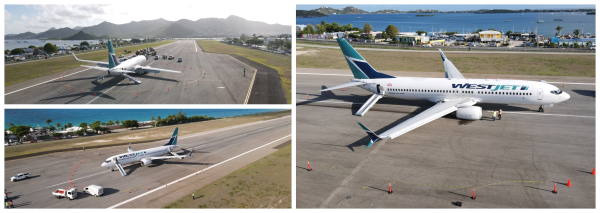 Ottawa / Philipsburg:--- An updated report from the Transportation Safety Board of Canada (TSB) has confirmed that the right main landing gear collapse of a WestJet Boeing 737-800 at Princess Juliana International Airport (SXM) on September 7, 2025, was not the result of a hard landing.
Ottawa / Philipsburg:--- An updated report from the Transportation Safety Board of Canada (TSB) has confirmed that the right main landing gear collapse of a WestJet Boeing 737-800 at Princess Juliana International Airport (SXM) on September 7, 2025, was not the result of a hard landing.
According to the TSB, a preliminary review of the aircraft’s flight data recorder (FDR) showed no indications of excessive landing force. The investigation has since turned its focus to a mechanical failure within the landing gear assembly.
Investigators discovered that the right gear’s aft trunnion pin had fractured — a critical component that connects the main gear to the aircraft structure. Both sections of the pin have been sent to the TSB Engineering Laboratory in Ottawa for detailed metallurgical examination.
The board also confirmed that the right main landing gear was last overhauled in 2016, and is now reviewing previous cases of aft trunnion pin fractures on other Boeing 737 aircraft to determine if this represents a broader safety concern.
The incident occurred as WestJet Flight WS2652 from Toronto was landing at St. Maarten. The right engine nacelle contacted the runway as a result of the gear collapse. No injuries were reported among passengers or crew, but the aircraft sustained significant structural damage.
The investigation remains ongoing, and a final report with findings and safety recommendations will be released once the analysis is complete.
For Background information:
Landing Gear Collapse at Princess Juliana International Airport — TSB Launches Investigation
A serious safety incident occurred on landing when a WestJet Airlines Boeing 737-800 (registration C-GWSR) touched down on Runway 10 at Princess Juliana with 157 passengers and 6 crew members aboard. During rollout, the aircraft’s right main landing gear collapsed, causing the right engine nacelle to scrape the runway surface. Thankfully, no major injuries occurred; all occupants evacuated via emergency slides, and only one minor injury was reported.
According to the official TSB investigation summary:
- The occurrence occurred on 7 September 2025 during the landing phase from Toronto’s Lester B. Pearson International Airport to St. Maarten.
- After touchdown, the right main gear collapsed. The aircraft sustained substantial damage and came to a stop on the runway.
- The evacuation proceeded via the left side of the aircraft, and only one minor injury was reported.
Key Technical Findings
- An initial review of the flight data recorder data did not indicate a hard landing.
- During the post-incident examination, the right gear aft trunnion pin was discovered fractured. The parts were sent to the TSB Engineering Laboratory in Ottawa for further analysis.
- That landing gear assembly had been overhauled in 2016, raising questions about wear, fatigue or other structural issues.
- The TSB is reviewing previous occurrences involving 737 series aft trunnion pin fractures to evaluate whether this is part of a recurring failure mode.
Investigation Process & Coordination
- Under the provisions of Annex 13 to the Convention on International Civil Aviation, the St. Maarten Civil Aviation Authority delegated the investigation to the TSB.
- The TSB deployed a team to the site and is working closely with the National Transportation Safety Board (NTSB) in the United States, the Federal Aviation Administration (FAA), Boeing, and WestJet for the technical and operational aspects.
- The investigation is classified as a Class 3 occurrence. Class 3 investigations focus on a small number of safety issues and may result in safety recommendations. They are typically completed within 450 days.
- Safety Implications
Landing gear collapse is a significant safety event with multiple potential consequences: risk of fire from engine nacelle contact, uncontrolled evacuation, damage to runway infrastructure, and threat to other aircraft operations. The fact that the gear collapsed despite no indication of a hard landing suggests a possible fatigue or structural failure of the component, rather than a pilot error or extreme landing scenario.
The investigation into aft trunnion pin fractures of Boeing 737 aircraft could have implications across fleets worldwide. If the TSB finds a design, maintenance, or inspection oversight, recommendations could follow that affect operators, manufacturers, and regulators globally.
Impact on St. Maarten Airport Operations
Despite the collapse and damage, the incident was handled swiftly, with evacuation completed and no serious injuries reported. However:
- The runway was blocked while the aircraft was removed, and damaged assemblies were documented—potentially leading to delays or cancellations for other flights.
- The airport's and the operators' reputations could be affected if it becomes known that a major carrier experienced gear failure on landing.
- The thoroughness of St. Maarten’s ramp inspections and gear maintenance standards may come under scrutiny by operators and insurers.
What’s Next
The TSB continues with the examination and analysis phase: testing fractured parts, reviewing maintenance history, reviewing any relevant previous occurrences, modelling loads, and evaluating inspection protocols. Once their internal review is complete, the TSB will produce a draft report, share it with interested parties (including Boeing, the carrier, and regulatory authorities), receive representations, and then publish a final report containing findings and, if warranted, safety recommendations.
For now, air-travel stakeholders — airlines, maintenance organizations, and airports — will closely watch for interim safety bulletins and updates from the TSB.
Sources: Air transportation safety investigation A25F0337.
Transportation Safety Board- Canada.












